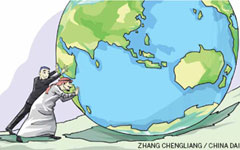|
 |
 |
On Sept 7, 2013, while visiting Central Asia, President Xi Jinping proposed that China and the countries of Central Asia draw on the inspiration of the ancient Silk Road and join hands to build on their friendly cooperation over the past 20 years to construct a Silk Road economic belt. This initiative represents a blueprint for common development and common security that will improve the lives of people throughout the region.
The trade volume between China and Central Asian countries has increased a hundred-fold over the past two decades, and China has become the biggest trade and investment partner of these countries. China's accumulative direct investment has reached more than $20 billion. In addition, cooperation among China, Russia and the four Central Asian states within the Shanghai Cooperation Organization has advanced smoothly.
With China's economy expanding, its foreign exchange reserves continue to increase and its foreign investment capabilities are growing. Over the next five years, the scale of China's foreign investment will reach $500 billion. China's new leadership is paying a great deal of attention to development and stability in Central Asia, which is closely related to China's national interests, and it is encouraging Chinese enterprises to "go out". At present, China has reached a series of cooperative agreements or memorandums of understanding with Central Asian countries in the fields of energy, communications, processing and manufacturing, agriculture and other areas.
The priority for the initiative at present is to develop transport corridors to promote regional economic integration and develop-ment. The collapse of the Soviet Union resulted in the fragmentation of the original traffic and communication systems in Central Asian countries, which are now seeking to strengthen the connectivity among themselves and with China. Kazakhstan has been focusing on the building of the western Europe-western China highway. Uzbekistan is promoting the construction of a railway linking China and Uzbekistan through Kyrgyzstan. While Kyrgyzstan and Tajikistan are striving to upgrade their existing transport and communication systems.
However, while the proposal to establish a Silk Road economic belt has been warmly received by the countries in Central Asia, realizing it does face some difficulties.
First, as a strategic vision, the initiative lacks details, targets in separate stages and implementation planning. This has also raised suspicions and speculation overseas about its purpose. Although the Central Asian countries appreciate the guiding significance of the economic belt in deepening their cooperation with China and promoting the development of bilateral relations in the future, specific problems need to be carefully studied and overcome. At the same time the purpose of the Silk Road economic belt and how it will be established need to be made clear to the outside world.
